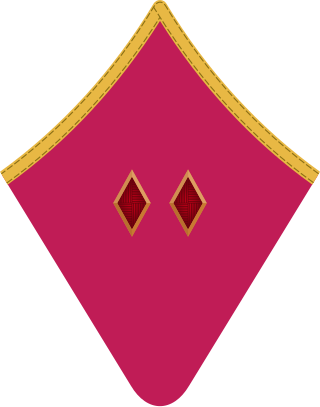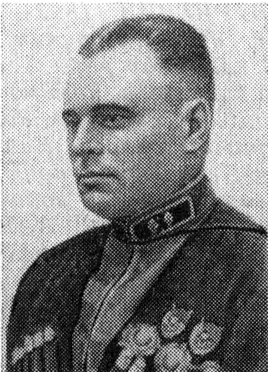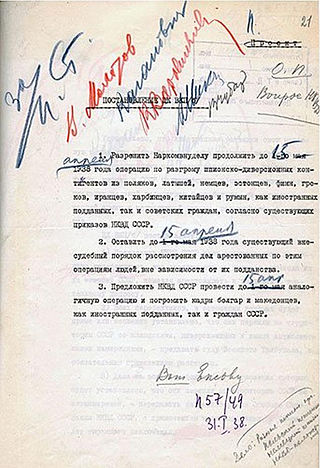The Stalinist execution list of July 26, 1938 was signed during the Great Purge of the Soviet Union by Joseph Stalin and Vyacheslav Molotov.
The Stalinist execution list of July 26, 1938 was signed during the Great Purge of the Soviet Union by Joseph Stalin and Vyacheslav Molotov.

Kombrig is an abbreviation of Commanding officer of the brigade, and was a military rank in the Soviet Armed Forces of the USSR from 1935 to 1940. It was also the designation to military personnel appointed to command a brigade sized formation (X).

Komdiv is the abbreviation to commanding officer of the division, and was a military rank in the Soviet Armed Forces of the USSR in the period from 1935 to 1940. It was also the designation to military personnel appointed to command a division sized formation (XX).

Between October 1940 and February 1942, in spite of the ongoing German attack on the Soviet Union in June 1941, the Red Army, in particular the Soviet Air Force, as well as Soviet military-related industries were subjected to purges by Stalin.

Komkor is the abbreviation for corps commander, and was a military rank in the Soviet Armed Forces of the USSR in the period from 1935 to 1940. It was also the designation for officers appointed to command a corps sized formation.
The following lists events that happened during 1937 in the Union of Soviet Socialist Republics.

The Kommunarka firing range, former dacha of secret police chief Genrikh Yagoda, was used as a burial ground from 1937 to 1941. Executions may have been carried out there by the NKVD during the Great Terror and until the war started; alternatively, bodies of those shot elsewhere might have been brought there for later interment. As Russian historian Arseny Roginsky explained: "firing range" was a popular euphemism adopted to describe mysterious and closely-guarded plots of land that the NKVD began to set aside for mass burials on the eve of the Great Terror.

Komandarm 2nd rank is the abbreviation to commanding officer of the army 2nd class, and was a military rank in the Soviet Armed Forces of the USSR in the period from 1935 to 1940. It was also the designation to military personnel appointed to command a field army sized formation (XXXX).

Komandarm 1st rank is the abbreviation to commanding officer of the army 1st class, and was a military rank in the Soviet Armed Forces of the USSR in the period from 1935 to 1940. It was also the designation to military personnel appointed to command an army group or front sized formation (XXXXX).
Ivan Ivanovich Smolin was a Soviet army commander. He fought in the Imperial Russian Army in World War I and in the Soviet Red Army in the Russian Civil War. He was a recipient of the Order of the Red Banner (1922). During the Great Purge, he was arrested on 14 May 1937 and later executed. After the death of Joseph Stalin, he was rehabilitated in 1955.
Grigory Petrovich Kireyev was a high-ranking commander in the Soviet Navy. He rose to command the Soviet Pacific Fleet in 1937. Kireyev was executed in 1938 during the Great Purge.
Johannes Raudmets was an Estonian Soviet Komdiv. He fought in the Imperial Russian Army in World War I before going over to the Bolsheviks in the subsequent civil war. He was a recipient of the Order of the Red Banner. During the Great Purge, he was arrested on June 11, 1937 and later executed. Some sources give the date of his execution as August 25, 1937. After the death of Joseph Stalin, he was rehabilitated in 1966.
The 2nd Cavalry Corps were a corps of the Red Army, formed twice. Originally formed in 1922, the corps served in Ukraine during the Interwar period and fought in the Soviet invasion of Poland.

Yakov Vasilyevich Sheko was a Red Army Komdiv.
Maxim Osipovich Stepanov was a Soviet komkor. He fought for the Imperial Russian Army in World War I before going over to the Bolsheviks during the subsequent civil war. He received the Order of the Red Banner twice. During the Great Purge, Stepanov's colleague division commissar Peter Maximovich Feldman was executed on August 22, 1938. On November 28, 1938, the Central Committee of the Communist Party of the Soviet Union made the decision to dismiss Stepanov from the military, which was carried out the next day. He was arrested on December 9, 1938. He initially pleaded guilty to the charges he was accused of, but then withdrew his plea. He was convicted on May 31, 1939 and sentenced to 20 years imprisonment. He survived the Second World War, but did not participate in it. He died shortly after the end of the Soviet–Japanese War of 1945 in a prison camp in Arkhangelsk Oblast. After the death of Joseph Stalin, he was posthumously rehabilitated on June 30, 1956.

The Latvian Operation was a national operation of the NKVD against ethnic Latvians, Latvian nationals and persons otherwise affiliated with Latvia and/or Latvians in the Soviet Union from 1937 to 1938 during the period of the Great Purge.

The Kharkov Military District was a military district of the Russian Empire, the Russian Soviet Federative Socialist Republic, and the Soviet Union. Throughout its history, the district headquarters was located in the city of Kharkov in northeastern Ukraine.
The leaders of the Russian Civil War listed below include the important political and military figures of the Russian Civil War. The conflict, fought largely from 7 November 1917 to 25 October 1922, was fought between numerous factions, the two largest being the Bolsheviks and the White Movement. While the Bolsheviks were centralized under the administration of the Russian Soviet Federative Socialist Republic and the Russian Communist Party (Bolsheviks), led by Vladimir Lenin, along with their various satellite and buffer states, the White Movement was more decentralized, functioning as a loose confederation of anti-Bolshevik forces united only in opposition to their common enemy - though from September 1918 to April 1920, the White Armies were nominally united under the administration of the Russian State, when, for nearly two years, Admiral Alexander Kolchak served as the overall head of the White Movement and as the internationally recognized Head of State of Russia. In addition to the two primary factions, the war also involved a number of third parties, including the anarchists of the Revolutionary Insurgent Army of Ukraine, and the non-ideological Green Armies.
Note: Except where otherwise stated, the date is that on which the individual was executed by shooting.
Directorate of Special Departments within NKVD USSR. rus. Управление Особых Отделов при НКВД СССР, (UOO) was an organization created in 1941 to conduct military counterintelligence under one command. The UOO was created to take back control from the retreating Red Army after the German invasion of the USSR and to counter German espionage efforts in the Soviet Armed forces. The principle tactic used by the UOO on Red Army personnel was intimidation and terror.
Under Military Law is a Russian - Ukrainian military - historical detective television series directed by Maxim Mekheda, Yevgeny Serov and Sergey Vinogradov, produced by the Star Media film company.